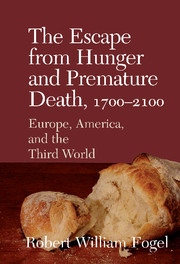Book contents
- Frontmatter
- Contents
- List of Figures
- List of Tables
- Preface
- Acknowledgments
- 1 The Persistence of Misery in Europe and America before 1900
- 2 Why the Twentieth Century Was So Remarkable
- 3 Tragedies and Miracles in the Third World
- 4 Prospects for the Twenty-First Century
- 5 Problems of Equity in Health Care
- Postscript: How Long Can We Live?
- Appendix
- Notes
- Glossary of Technical Terms
- Biographical Notes
- References
- Index
- Cambridge Studies in Population, Economy and Society in Past Time
2 - Why the Twentieth Century Was So Remarkable
Published online by Cambridge University Press: 05 June 2012
- Frontmatter
- Contents
- List of Figures
- List of Tables
- Preface
- Acknowledgments
- 1 The Persistence of Misery in Europe and America before 1900
- 2 Why the Twentieth Century Was So Remarkable
- 3 Tragedies and Miracles in the Third World
- 4 Prospects for the Twenty-First Century
- 5 Problems of Equity in Health Care
- Postscript: How Long Can We Live?
- Appendix
- Notes
- Glossary of Technical Terms
- Biographical Notes
- References
- Index
- Cambridge Studies in Population, Economy and Society in Past Time
Summary
Research during the past two decades has produced significant advances in the description and explanation of the secular decline in mortality. Although many of these findings are still tentative, they suggest a new theory of evolution that Dora Costa (an economist and biodemographer at MIT) and I call “technophysio evolution.” Studies of the causes of the reduction in mortality point to the existence of a synergism between technological and physiological improvements that has produced a form of human evolution that is biological but not genetic, rapid, culturally transmitted, and not necessarily stable. This process is still ongoing in both rich and developing countries. In the course of elaborating this theory, thermodynamic and physiological aspects of economic growth will be defined, and their impact on economic growth rates will be discussed.
Unlike the genetic theory of evolution through natural selection, which applies to the whole history of life on earth, technophysio evolution applies only to the past 300 years of human history and particularly to the past century. Despite its limited scope, technophysio evolution appears to be relevant to forecasting likely trends over the next century or so in longevity, the age of onset of chronic diseases, body size, and the efficiency and durability of vital organ systems. It also has a bearing on such pressing issues of public policy as the growth in population, in pension costs, and in health care costs.
- Type
- Chapter
- Information
- The Escape from Hunger and Premature Death, 1700–2100Europe, America, and the Third World, pp. 20 - 42Publisher: Cambridge University PressPrint publication year: 2004
- 1
- Cited by



